 Open Access
Open Access
ARTICLE
A New Strategy for Dynamic Channel Allocation in CR-WMN Based on RCA
1 Faculty of Information Technology, Beijing University of Technology, Beijing, 100124, China
2 Department of Computer Science, Preston University Kohat, Islamabad Campus, Islamabad, 44000, Pakistan
3 Department of Computer Science and Information Technology, University of Sargodha, Punjab, 40100, Pakistan
4 College of Applied Sciences, Beijing University of Technology, Beijing, 100124, China
* Corresponding Author: Kaleem Arshid. Email:
Computers, Materials & Continua 2023, 76(3), 2631-2647. https://doi.org/10.32604/cmc.2023.035735
Received 01 September 2022; Accepted 17 February 2023; Issue published 08 October 2023
Abstract
Channel assignment has emerged as an essential study subject in Cognitive Radio-based Wireless Mesh Networks (CR-WMN). In an era of alarming increase in Multi-Radio Multi-Channel (MRMC) network expansion interference is decreased and network throughput is significantly increased when non-overlapping or partially overlapping channels are correctly integrated. Because of its ad hoc behavior, dynamic channel assignment outperforms static channel assignment. Interference reduces network throughput in the CR-WMN. As a result, there is an extensive research gap for an algorithm that dynamically distributes channels while accounting for all types of interference. This work presents a method for dynamic channel allocations using unsupervised Machine Learning (ML) that considers both coordinated and uncoordinated interference. Unsupervised machine learning uses coordinated and non-coordinated interference for dynamic channel allocation. To determine the applicability of the proposed strategy in reducing channel interference while increasing WMN throughput, a comparison analysis was performed. When the simulation results of our proposed algorithm are compared to those of the Routing Channel Assignment (RCA) algorithm, the throughput of our proposed algorithm has increased by 34% compared to both coordinated and non-coordinated interferences.Keywords
The proposed framework may well aid in developing of a comprehensive reaction to inadequacy, odd acknowledgment, shirking, and augmentation to outline availability and capacity under any conditions.
In wireless networks, interference lowers communication dependability and, consequently, network performance. IEEE 802.11, the Institute of electronics and electrical engineers, integrates partially or entirely non-overlapping channels with a variety of radio interfaces [1]. WMRs based on IEEE 802.11 have multiple radio interfaces that use available non-overlapping or partially overlapping channels. IEEE 802.11a uses 12 non-overlapping channels in 5.8 GHz bands, but IEEE 802.11b/g utilizes three non-overlapping channels in 2.4 GHz bands. WMRs may communicate with a large number of neighboring nodes at the same time by employing multiple radios and non-overlapping channels. As a result, when using wireless signal transmission signals, the node may receive all signals within its broadcast range and send data to all indications equally; however, it encounters a significant problem due to (channel) interference [2].
The current research does not sufficiently investigate all aspects of constructing an MRMC CR-WMN with dynamic channel assignment to increase throughput. One of the primary issues is interference. Before transmission, a channel is selected from among the links based simply on the node’s transmission range, and disregarding the same channel used in the Carrier Sense range (CSrange) can produce interference. A channel allocation system is necessary to overcome the interference problem. In CR-WMN, RCA is a dynamic channel assignment mechanism. This algorithm assigns channels based on information from adjacent nodes within the transmission range, but it does not take into account nodes within the carrier sensing range. However, this technique ignores nodes in the CSrange; in RCA, the same channel is assigned to two different transmission links in the CSrange, affecting throughput due to coordinated and non-coordinated interference [3]. When allocating channels to links in prior works, authors primarily consider the assigned channels, which are mostly on adjacent connections that are within the communication range. While the authors noted the interference scale, when allocating a channel to a communication link, they completely ignored nodes and connections outside the TRrange and within the CSrange. However, by considering this crucial characteristic before allocating a dynamic channel to virtually every route in the CR-WMN, they ensured that interference was kept to a minimum by taking into account routes and nodes close to one another.
The goal of this study is to offer a strategy for reducing interference by avoiding allocating the identical channel that is currently being used by any connection within CSrange. Cross-layer dynamic channel allocation procedures were improved such that they now allocate channels to CR-WMN links and linkages outside of the TRrange and CSrange. This study enhances the field of CR-WMN by increasing network throughput.
The paper is organized as follows: first, the CR-WMN implementation and architecture are discussed; then, the state of the art on interference and MRMC wireless mesh networks is described, along with different existing algorithms and methods used to minimize the interference. Next, about the proposed algorithm and how it reduces interference by taking the CSrange into account. Finally, the results achieved by the simulation of the proposed algorithm are presented, and the output is concluded.
Diverse challenges are available on wireless networks, though various solutions are also proposed. The initial wireless internet standard for the future is called CR-WMN. It has radio nodes arranged according to mesh topology [4]. Nodes in such a network are either stationary or mobile. Each node forwards messages according to other nodes. Mesh networks can “self-heal”, which means these networks automatically re-route around a node that has lost power. WMNs are employed in various application contexts, including social security networks, college networks, mobile telephony backhaul networks, and broadband last-mile internet access. It offers a very dependable and affordable substitute for internet connectivity across border zones. Moreover, these networks have been intensely used in academia, industry research, and enterprise and community networks because of their self-organizing and self-configuring nature. In WMN, one node can robotically create and sustain mesh connectivity [5].
WMN architecture, Fig. 1 has three groups considering its node functionality [6], namely, infrastructure for a wireless mesh network, mesh routers, and communication. The infrastructure-based wireless mesh network approach is called backbone meshing because it provides a backbone for conventional clients. These are the most commonly used types of WMN. Additionally, it makes it possible for WMN to be integrated with the current wireless networks due to gateway features in mesh routers. Connected mesh routers form a network of self-healing links. Communication networks take place by using methods with a more extensive range, e.g., directional antennas. For home users, mesh routers used as access points are located on the roofs [7].
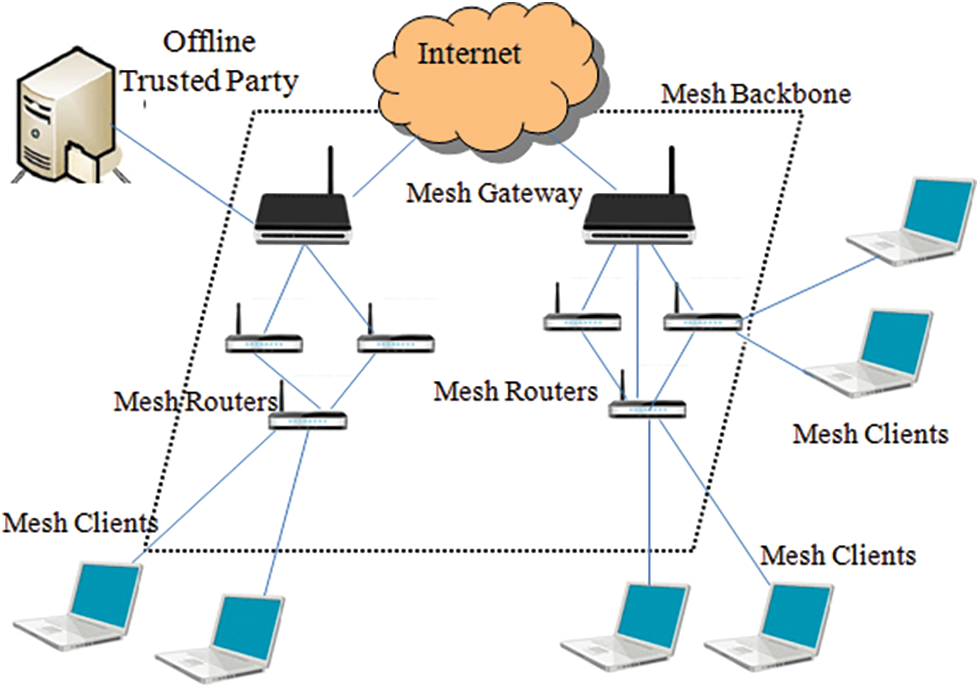
Figure 1: Architecture of CR-WMN ([6])
Nodes contain the network for routing and configuration features in the meshing technique, which helps customers with end-user applications. WMN nodes in access points that wireless clients share and backhaul data forwarded between two access points typically use only one radio on a single channel [8]. Another problem that impairs network performance is radio interference. Transmission errors may also result from it. The same channel is used throughout the network, much like a single radio method. If any portion of the network experiences interference, this lowers the performance of the entire network [9]. Moreover, when it is used for channel assignment to reduce interference, connectivity issues also occur, and even disconnectedness takes place. Therefore, it is difficult to integrate fault tolerance or synchronization of neighboring nodes on the same channel to communicate. Due to these problems, the throughput limit becomes a problem, so WMNs have switched from a single-radio, single-channel architecture to MRMC architecture.
In light of this, all current WMN deployments adhere to the MRMC architecture, which uses multiple radios and non-overlapping channels on each node. Communication between these radios may co-occur due to how network throughput is maximized. By using multiple channels, adjacent links in the network carry traffic that is free from interference. Therefore, delays in the link layer can be reduced [10].
Instead of many benefits in the multi-channel wireless mesh network, in Fig. 1, there are some problems in communication between nodes due to which proper channel coordination is required. It consists of interference, channel assignment, synchronization, broadcasting, etc. The problem of channel allocation is NP-hard [11]. Interference has a significant influence on the network since it increases delay, reduces throughput, and results in high packet loss. These issues are resolved using static and dynamic channel assignment algorithms [12]. Every mesh router’s interface receives a permanent channel allocation under the static channel assignment technique. Even if the goal is to reduce interference, this method can only move channels so far because it changes the network topology and the time.
Thus, the channel assignment problem can be resolved dynamically [1] to reduce interference between the nodes while communicating. According to studies, interference is the factor that lowers network performance. It occurs when two or more nodes want to communicate simultaneously on the same channels while being within interference range of one another. It will increase the packet loss rate, increase delay, and decrease network throughput. There are two categories of interference in wireless mesh networks: If the source nodes of two connections are within CSrange of one another, the links are said to be coordinated interfering links. Non-coordinated interference is further divided into three types: (i) If two links, L1 (s1, r1) and L2 (s2, r2), use the same channel, the following requirements must hold for information asymmetry to interfere [13]:
d (s1, s2) > CSrange
d (r1, s2) < CSrange
d (s1, r2) > CSrange
If the source nodes s1 and s2 are outside of each other’s CSrange, along with the nodes s1 and r2, but s2 and r1 are, then in this scenario, interference from L2 can cause flow on L1 (s1, r1) to be reduced (s2, r2). Where d represents the actual separation between the nodes, (ii) Near Hidden Interference: The following need must be met for near-hidden interference, considering that L1 and L2 are two linkages:
d (s1, s3) > CSrange
d (r1, s3) < CSrange
d (s1, r3) < CSrange
According to Fig. 2, the source nodes s1 and s3 are outside of the CSrange. However, both links’ receivers are inside the TRrange of their source nodes. These links will be interfered with if transmission occurs on the same frequency channel. The third type of non-coordinated interference is far-hidden interference (iii). Accordingly:
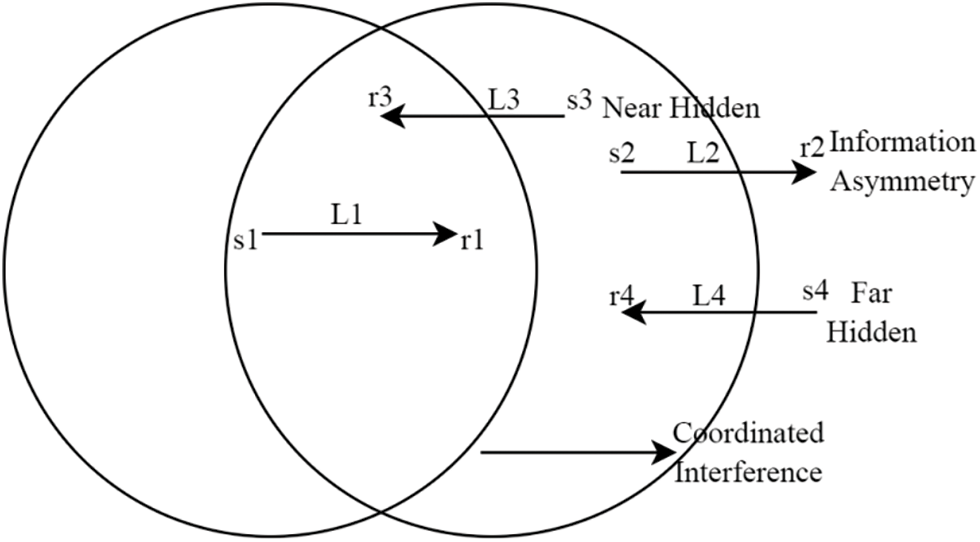
Figure 2: Types of interference in WMN
d (s1, s4) > CSrange
d (r1, s4) > CSrange
d (r1, r4) < CSrange
In this case, only the receivers of links 1 and 4 can sense each other. Besides, when the same channel transmits, both r1 and r4 can sense each other. This results in traffic loss that significantly affects network throughput.
The links that could potentially interfere with any other link in the network are defined using the interference model [14]. Two interference models are frequently used to establish whether a wireless transmission was effective. According to the protocol model, a transmission between two nodes is successful if the distance between them is less than or equal to the source node’s transmission range and none of the nodes in the source node’s CSrange are participating in the transmission. If the interference signal and signal-to-noise ratio of the transmitter signal to the receiver are greater than the limit value, the visual model transmission will be successful.
When there are fewer radio waves available, the author in [15] highlights the channel allocation problem and states that the issue can be resolved by lowering the maximum network interference. The authors have presented distributed and intermediate algorithms that offer channels for network links. Authors colored in contradictory graph sections using the tabu search procedure. It can only be used on a stationary network because it can lead to network stress. In addition, developing a specific program for this optimization problem shows the best solutions stated in the proposed algorithms. Existing studies on channel allocation have paid attention to static assignment approaches, but these strategies have the drawback that they reallocate the channels to solve errors. In contrast, a node in a multi-channel network can connect with any zone within a set amount of time. By using more channels in this area, interference rises. Therefore, it is crucial to address the interference issue and boost network efficiency. It was suggested [16] that a centralized, measurement-based method for assigning static channels to radios instead of connections be used to solve the problem of channel allocation and improve network throughput.
Dynamic interference-aware channel allocation algorithm for MRMC CR-WMN to address interference problems between mesh networks within WMN, as well as co-located CR networks [17]. To achieve these goals, a channel assignment server (CAS) is used for channel allocation to radios. For CAS to minimize interference between mesh routers, it must meet three requirements. (1) A common channel should be assigned to connect the two end nodes. (2) Links that can communicate must have non-overlapping channels. (3) Due to the WMN’s tree-shaped traffic pattern, a link that originates at the gateway should be given priority for allocating channels. CAS initially assesses interference from mesh routers and selects the channel for default radios to reduce interference between the WMN and the collocated wireless network. The default channel’s goal is to reduce interference between co-located wireless networks and mesh networks. CAS constructs a multi-radio conflict graph (MCG) to run radios on the channel with the least amount of interference from external radios for non-default radios in the mesh. Utilize the breath first search algorithm next to choose the channel for your mesh routers. The search in this technique starts at the link leading from the gateway node.
This method starts by adding each vertex from MCG to the list of “let L.” visit all vertices and assign channels to them; it will perform a breadth-first search. The search for the vertex with the shortest hop count begins with links related to the gateway, and any vertices with distances equal to the most minor hop count are added to a queue. Since the linkages have a high priority since they have a low hop count, these vertices are then sorted by increasing the delay values. The method then gives them a channel that is permanently assigned and does not compete with the channel assignment of their neighboring nodes. Vertices are taken from the MCG and put into a list L after being assigned a channel. It makes sure that each radio is given a single channel. If there is not a non-conflicting channel available, one is randomly chosen and given to the vertex permanently. This process continues until all MCG vertices have been visited [18].
The shared routing problem was solved using the MCWMN architecture [19]. The distributed channel assignment technique used in this work, which determines the route, is based on local topology and load data. This data is gathered from nodes that are K + 1 neighbors away. At the same time, k is the proportion of CSrange to Trange. In this method, several spanning trees are employed to distribute the load among the trees, assuming that the node may join numerous spanning trees. In addition, nodes in higher positions in a hierarchy of trees have a higher priority when linked to the internet, whereas nodes in lower positions have a lower priority. This will lead to the discrimination of those nodes, which negatively impacts their performance and communication. Although the throughput was increased and handoff management-based network management was used [20], the learning significance was not fully utilized. Recent studies [21] suggest employing an optimal channel assignment technique in MRMC wireless mesh networks to reduce non-coordinated interference. This method boosts performance in sparse networks by 19%. The only restriction is that this model can only be utilized with non-overlapping channels. To increase network throughput, channel assignment that partially overlaps is also necessary.
A technique for allocating channels that uses marginally overlapping channels. This shows where the problem is and how it will be fixed across all network links. The distance from the gate, the number of neighbors, and the distraction used to characterize the channel transmission are employed because traffic between the internet and customers should be at its optimal level [22].
The gateways can talk to each other using a load-balancing protocol to send traffic from gateways that are too busy to gateways that are not being used enough [23]. By studying the simulation results, it attempts to improve the shortest path method in order to solve the interference problem. Compared to the shortest path algorithm, this protocol can increase throughput by up to 80%. The distributed channel assignment technique used by [11] resolves the problem of channel assignment by allowing each node to choose a channel in a greedy manner. By relying on its local knowledge, it will reduce the effectiveness of its local objective function. Additionally, each node selects a channel that lowers the total cost of interference in its interference range. The good thing about this method is that each node’s assigned channel is based on local information, but the bad thing is that it does not considering interface cards per node or interface violation constraints.
The interference-aware topology of dynamic traffic has been studied, and a new definition of co-channel interference has been presented [17]. Moreover, this work presents a heuristic to resolve the issue of interference survivable topology control. Moreover, by comparing the results from existing schemes, this method gives better performance [24]. They worked on the channel assignment problem by using ant colony optimization, in which intelligent ants are used for the routing and channel assignment to minimize overall network interference. Its algorithm consists of two parts. Channel assignment is used to find out the channel that each radio interface should use, and routing is used to select the paths for the flow from sender to receiver. Moreover, traffic is assigned to each link to ensure dynamic channel assignment according to traffic patterns. This architecture reduces interference, but it has the limitation that even if channel switching occurs on some network links, the network is still connected or not. The authors in this paper compared their algorithm results in multi-channel mesh networks with the static channel assignment method [25]. They compare their results for pack delivery ratio and a number of flows using both orthogonal and partially overlapping channels. The simulation results show that RCA can successfully ensure performance and enhance network throughput. Still, there is a limitation in this approach: that they ignore the effect of interference caused by CSrange as the same channel is allocated in the CSrange of a node that communicates.
In [26], the authors proposed a Hybrid Sensor Selection (HSS) technique that combines the classification model to quickly collect a sensor sample with rich information. By employing the ideal number of devices. The correctness of WMN is not compromised while maintaining the necessary degree of accuracy.
In this research [27], the authors addressed both downlink and uplink communication. In the future, hardware and independent processing may be added to large transmission systems to save energy and promote ultra-high bandwidth. However, more research is still needed to figure out how to use ML to improve throughput.
This paper presents a novel, dependable, and energy-efficient mobile agent-based method for wireless networks while not considering the interference during the handoff from one route to the other [28].
The primary goal of this publication is to enhance the ride-hailing system’s cognition and security by including blockchain architecture. They are relying on cab usage patterns by using WMN. Therefore, they are not considering any ML technique [29].
A particle swarm optimization technique is also implemented in CR-WMN to determine the most minor identifiable energy report variation from a valid user by fraudulent users; therefore, they are not considering solutions to the interference problem by using ML [30].
Static assignment methods have received attention in past findings on channel allocation. This strategy has the issue of requiring the redeployment of channels to correct errors. In contrast, a station in a multi-channel system can connect with any region within a set amount of time. Using extra channels increases interference in such areas. Therefore, it’s crucial to address the interference issue and boost network efficiency.
In the proposed work, the base algorithm allocates channels to the links only by considering the allocated channels on the neighboring links, which are in the transmission range. Although the authors discussed the interference range when allocating a channel to a transmission link, nodes/links outside the TRrange and inside the CSrange were completely ignored. But this work took this essential factor into account in the proposed algorithm and reduced interference by taking into account the links/nodes that are in CSrange of each other before assigning a dynamic channel to any link in the CR-WMN.
Each node in the CR-WMN has its transmission range and carrier detection range. Nodes can communicate using the same frequency channel, as is common knowledge. The RCA algorithm has been applied to multi-radio WMN. In this method, every node generates a table for channel information. The channel is allocated when a transmitter broadcasts the packet to forward it to the next hop. Moreover, channels are dynamically changed according to the routing information of adjacent nodes. But this study has a limitation in that only the transmission range is considered to check the interference of the same channel between the links. However, the nodes that are beyond the transmission range but in the carrier sensing range have a severe effect on the network throughput [2]. To cope with the limitations of the algorithm mentioned below in Table 1, this research developed a new dynamic channel allocation algorithm, given:
1. Start
2. Do
3. If (C-cur = free), then if the channel is free within the broadcast range and there is no interference, assign it to the link; if no channel is free, wait for the available channel.
4. Keep pending for a free channel.
5. else {while (C-pre = Yes)} (If the channel is available and is non-interferential, then the node will update its current available channel lists,)
6. C-cur = C-pre
7. Determine the route to the next node for expected channel C-pre
8. Calculate the expected calculation time of transmission t pre
9. If no channel is available, compare the received t pre with its t-pre
10. If (t-pre’ < t-pre), inform about the route to the other node;
11. Else wait for a channel.
12. Determine t pre and update channel information;
13. Inform about its address to the next node;
14. If a node responds, inform about the last hope that another node
15. If pending responds, save the address.
16. Direct all nodes before waiting for the available channel;
17. Direct next hop to store its address
18. Else continue routing.
19. Repeat if the destination node is not found, and continue the channel assignment

The process outlined above allows the channels to be used when a node sends packets and frames to the next hop. A node A’s broadcast packet contains routing and Cpre information when it routes. If Channel is not being used for communication and the broadcast packet is received by nearby nodes, then Ccur is updated. Other nodes will choose the next step on their own and will not affect node A if they route to one of these.
In the proposed work, select the channel between the sender and receiver by considering all the nodes in the CSrange of both nodes. If any link is using any channel for transmission, then the same channel cannot be allocated to any other link within the CSrange of the sender or receiver. Figs. 3 and 4 depict the entire process of our suggested algorithm, demonstrating both successful and failed transmission.
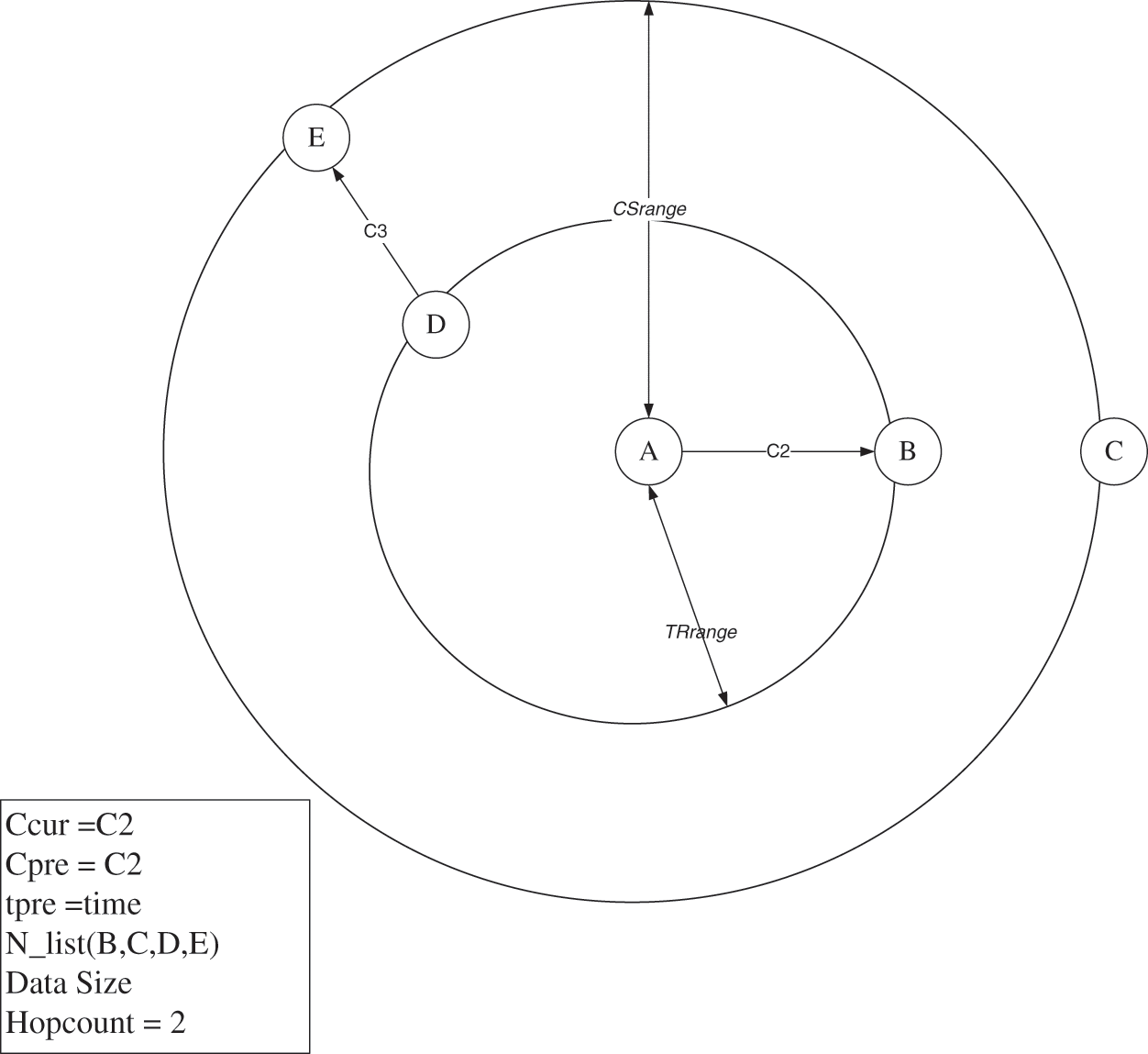
Figure 3: Successful transmission
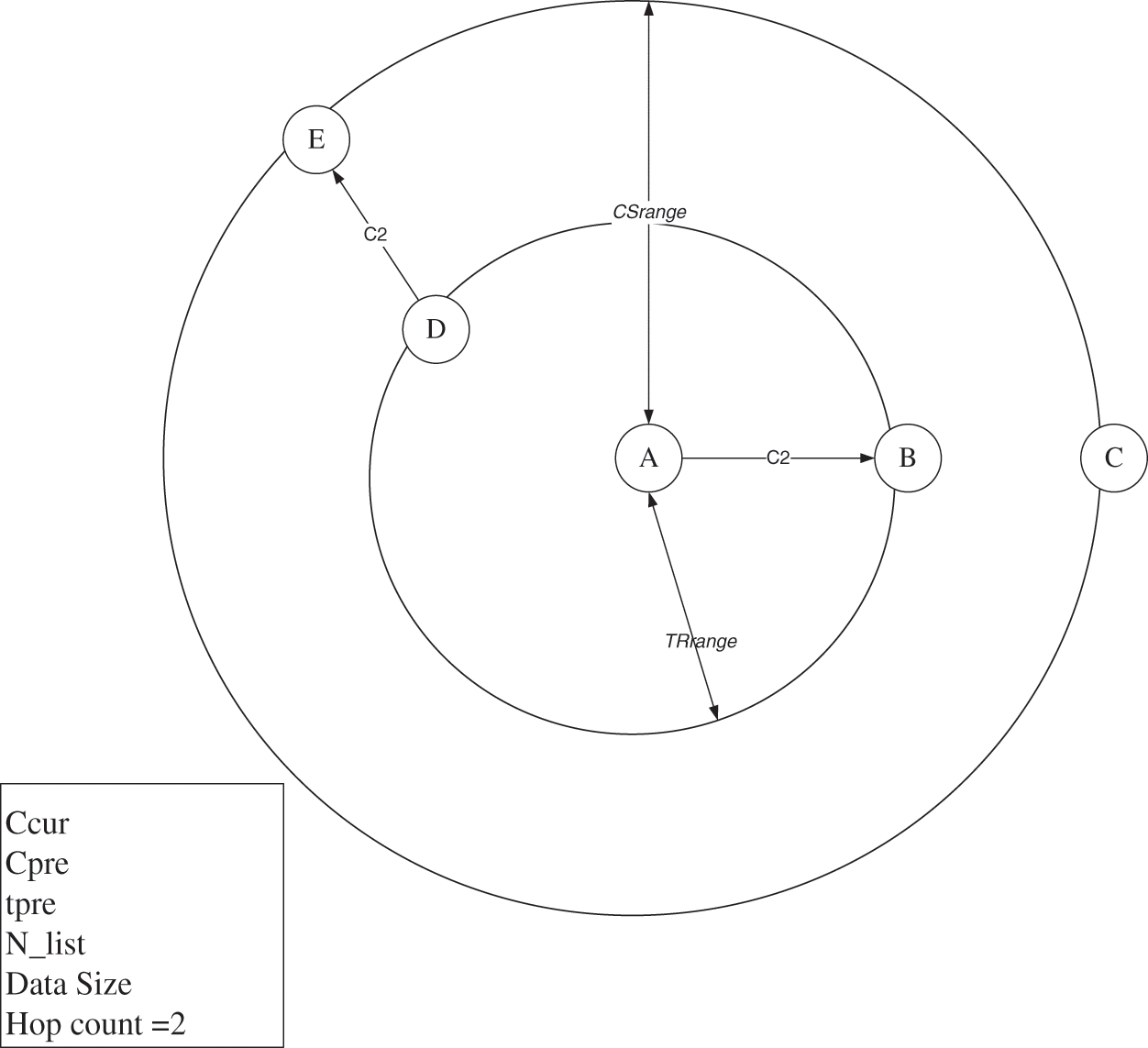
Figure 4: Unsuccessful transmission
Fig. 3 shows that if node A wants to communicate with node B using channel C2, then for communication, first of all, node A broadcasts a packet on channel C1 (control channel) that contains channel information, i.e., Cpre, Ccurr,tpre, hop-count = 2, and N_list (B, C, D, E). Where N list is a list of all nodes within node A’s CSrange. The route discovery packet is broadcast by Node A to all nodes in the TRrange. Node B, when receiving the packet, decrease the hop-count by 1 and then forwards this packet to all of its neighbors, e.g., node C. Node C decrese the hop-count by 1, which turns hop-count = 0. When the hop-count reaches zero, C stops broadcasting. In this case, the study is making the assumption that the broadcast routing packet gets to all of node A’s neighbors in the CSrange in two hops.
In the route reply procedure, all the nodes in the N list reply with the channel being used by them. Node A checks whether channel C2 is available in its transmission ranges (TRrange and CSrange) or not. As in this research example shown in Fig. 3, there is only one transmission link between nodes D and E, communicating on channel 3. Therefore, in a successful reply, the proposed algorithm allocates channel 2 to the transmission link between nodes A and B. Also, it updates the Ccurr = 2 in the table of node A.
Fig. 4 shows that if node A wants to communicate with node B using channel C2, then for communication: first of all, node A broadcasts a packet on channel C1 (control channel) that contains channel information, i.e., Cpre, Ccurr,tpre, hop-count = 2, and N_list (B, C, D, E). Where N_list is a list of all neighboring nodes in node A’s CSrange, of node A. Node A broadcasts the route discovery packet to all the nodes that are in the TRrange. Node B, when receiving the packet, decrements the hop-count by 1 and then forwards this packet to its neighbors, e.g., node C. Node C decrements the hop-count by 1, which turns the hop-count = 0.
C stops broadcasting when the hop-count reaches zero. The research assumes that the broadcast routing packet reaches all the CSrange neighbors of node A in two hops. In the route reply procedure, all the nodes in the N list reply with the channel being used by them. Node A checks whether channel C2 is available in its transmission ranges (TRrange and CSrange) or not. As in the research example shown in Fig. 4, this work has a transmission link between nodes D and E that also communicates with channel 2. As a result, in an incorrect answer, the proposed algorithm does not assign channel C2 to the link between nodes A and B for data transmission.
In simulation, the research work created a network topology consisting of 5 wireless nodes, as shown in Fig. 5. We looked at two single-hop flows to see how interference could explain the difference in throughput. The channel information for nodes is based on IEEE 802.11b. The simulation time is 10 s. The TRrange is 35 m, and the CSrange is double that, i.e., 70 m. In all the scenarios given below, flow1 is between nodes A and B, whereas flow2 is between nodes D and E.
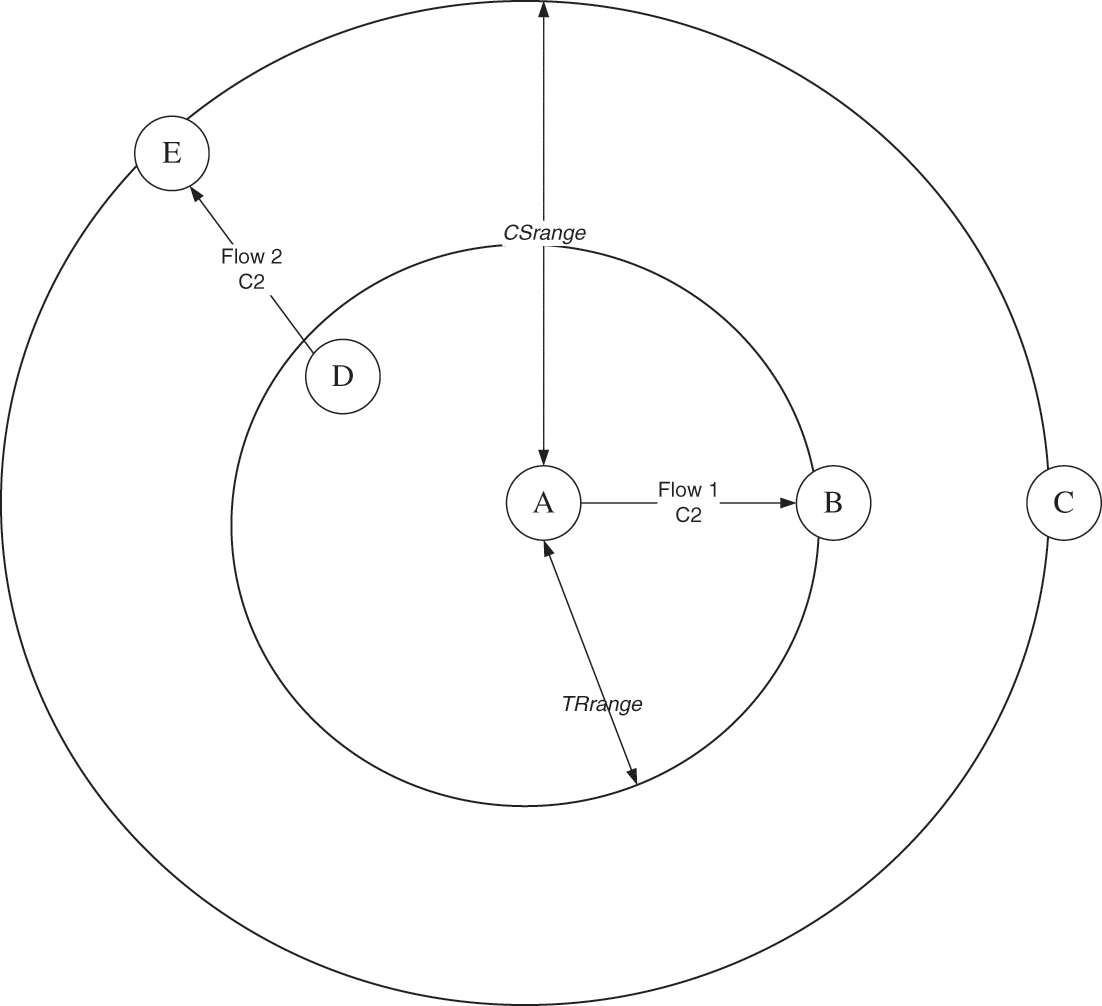
Figure 5: Throughput of RCA
In the first scenario, discuss the base-paper strategy by which communication between any two nodes takes place by considering only the transmission range. Nodes C, D, and E are in the CSrange of node A. When the nodes A and B want to communicate using channel C2, at the same time, this channel is used by the links D and E within the transmission range of A. Both transmitting nodes A and D are within the TRrange of each other and use the same channel, so they share the channel capacity without interfering with each other. The simulation result shows that in this case, the throughput of flow 1 is 2.7 and flow 2 is 2.6, whereas the aggregate the throughput is 5.3 Mpbs, as given in Table 2. Fig. 5 shows the topology for the throughput of RCA.

4.1 Effect of Coordinated Interference Using RCA
Discuss the second scenario of coordinated interference in Fig. 6. It shows that when the nodes A and B want to communicate using channel C2, then at the same time, this channel is used by the links D and E within the CSrange of A. Both transmitters do not know each other and interfere. The simulation result shows that due to interference, throughput decreases from 5.3 to 4.7 Mbps, as shown in Table 2.
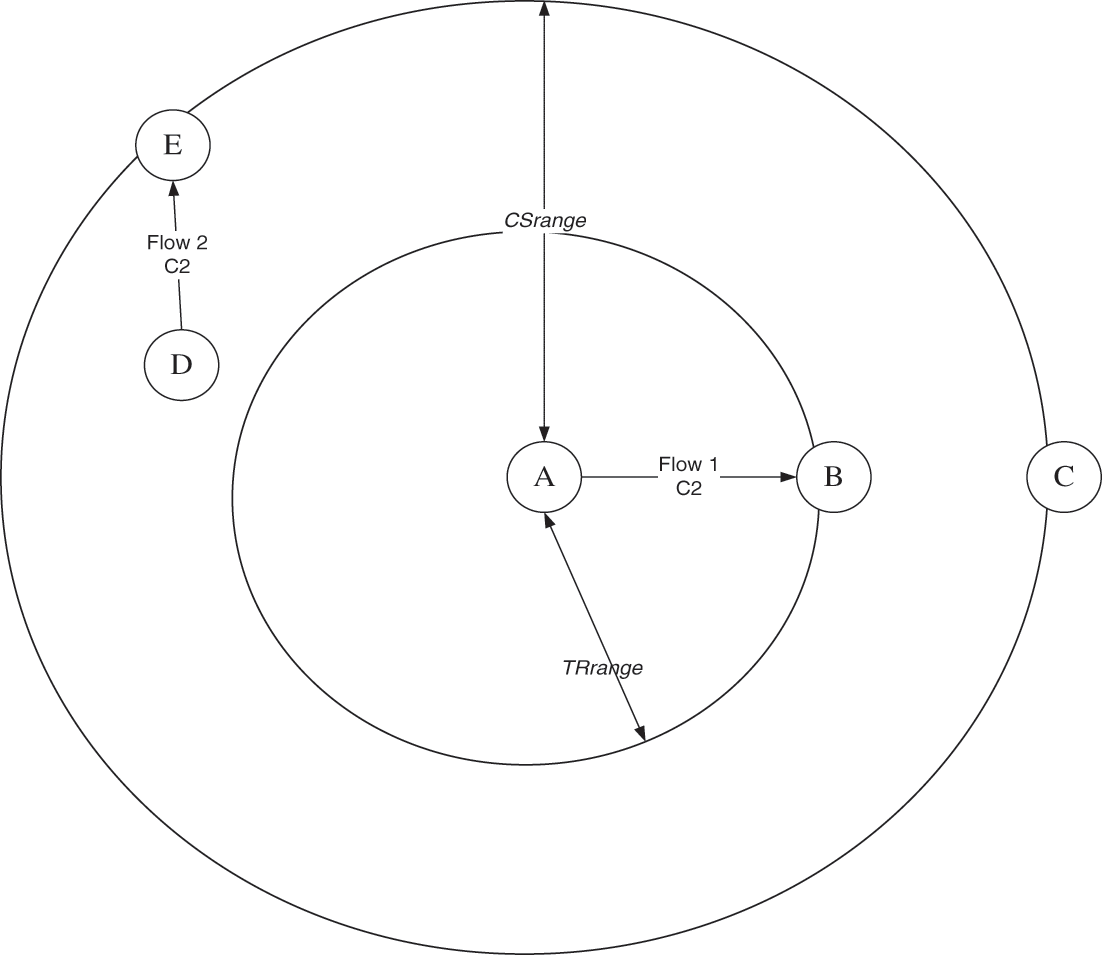
Figure 6: Throughput of RCA w.r.t coordinated interference range
4.2 Effect of Non-Coordinated Interference Using RCA
Discuss the third scenario of non-coordinated interference in Fig. 7. It shows that when the nodes A and B want to communicate using channel C2, at the same time, this channel is being used by the links D and E within the CSrange of A. Both transmitters don’t know each other and interfere. The simulation result shows that due to interference, throughput increases from 4.7 to 8.5 Mbps, as shown in Table 2.
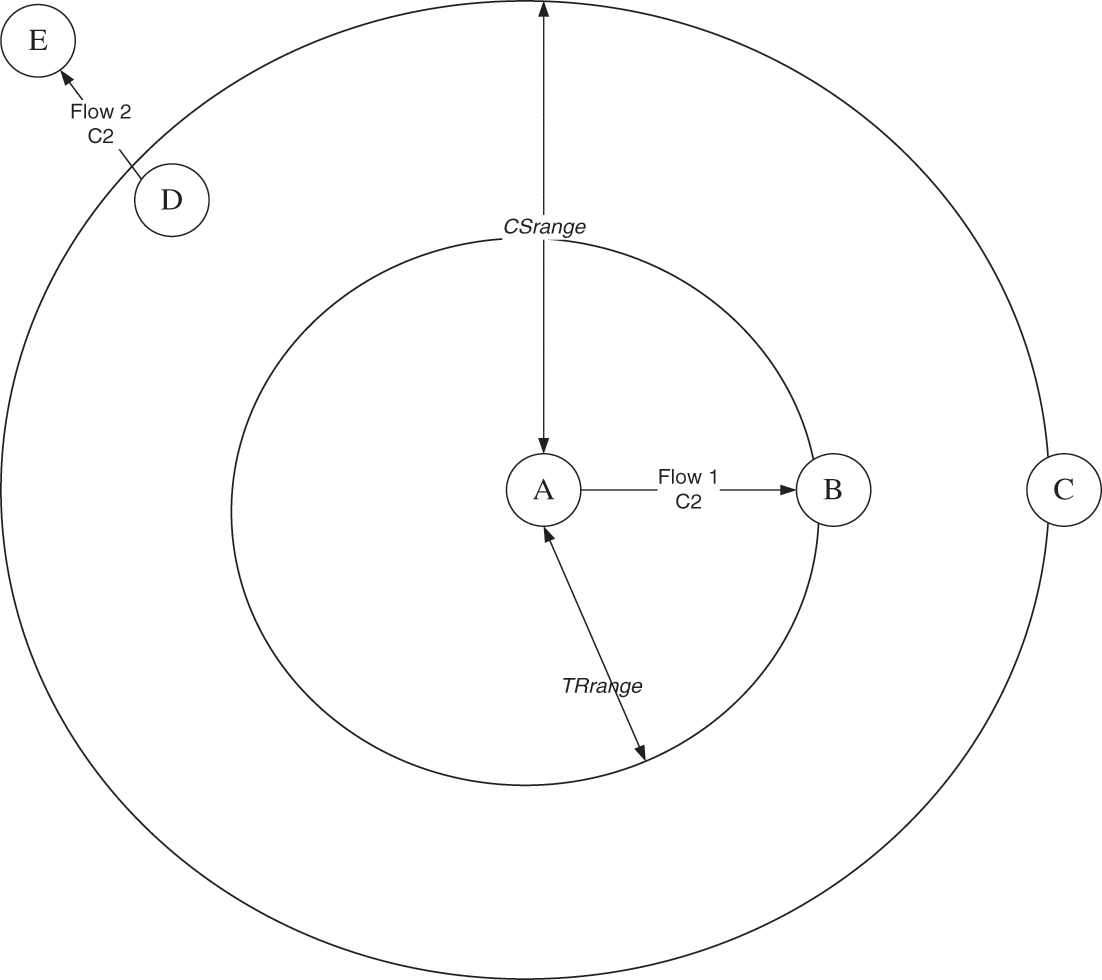
Figure 7: Throughput in RCA with w.r.t non-coordinated interference
Discuss the fourth scenario of non-coordinated interference in Fig. 8. It shows that when the nodes A and B want to communicate using channel C2, at the same time, this channel is being used by the links D and E outside the CSrange of A. So, both transmitters do not interfere with each other. The simulation result shows that throughput in this scenario increases from 8.5 to 10 Mbps, as shown in Table 2.
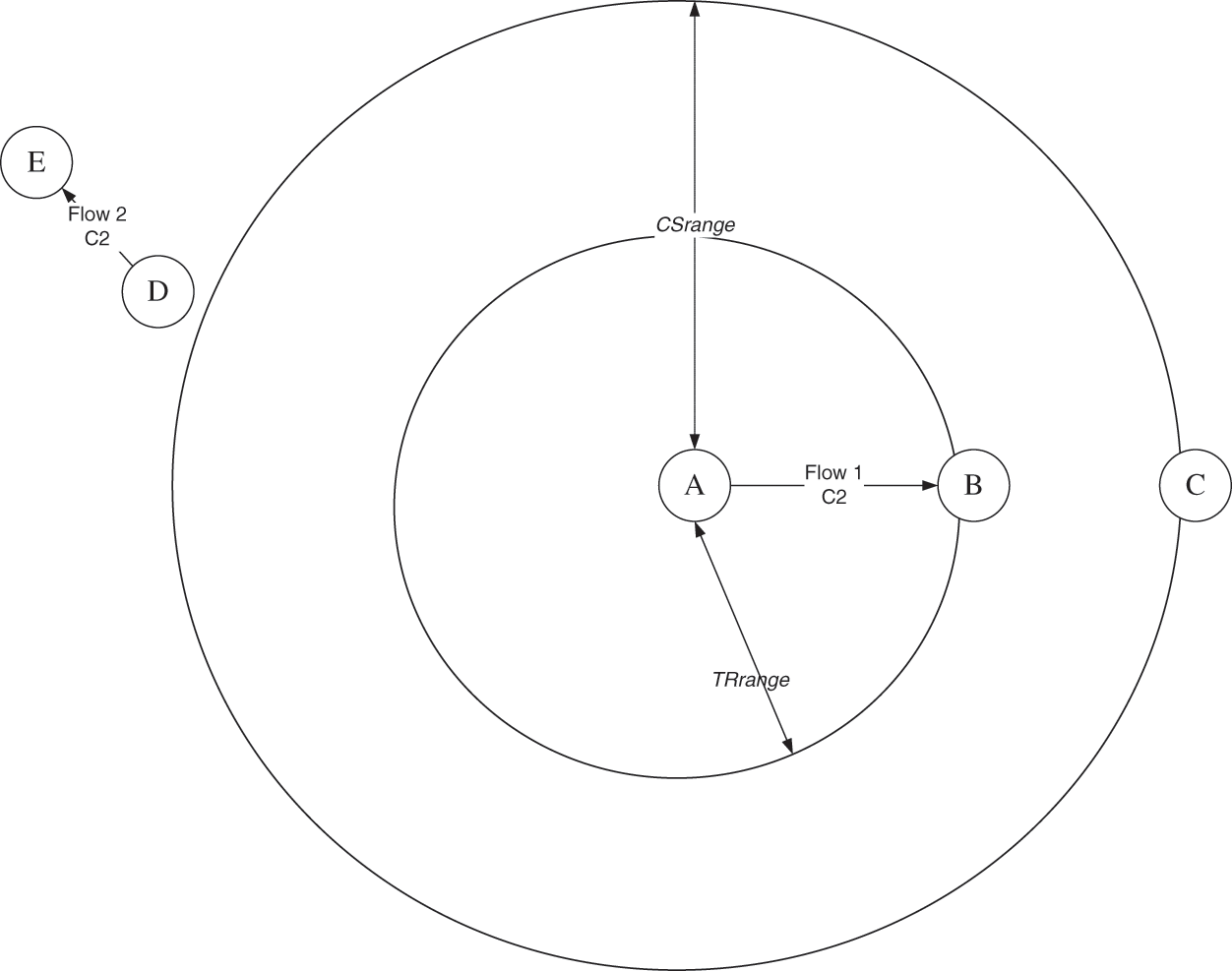
Figure 8: Throughput for the links outside CSrange
4.3 Channel Allocation Using the Proposed Algorithm
In the last scenario, Fig. 9, the research team considered the same topology as discussed in Fig. 5. The only difference is that our proposed algorithm does not allow the same channel on both links simultaneously. It allocates channel 2 for flow 2, whereas channel 3 for flow 1, because both are in the CSrange of each other. Due to this channel allocation, the network’s throughput increases from 5.3 to 10 Mbps, as shown in Table 2. Fig. 7 shows the throughput of our proposed algorithm.
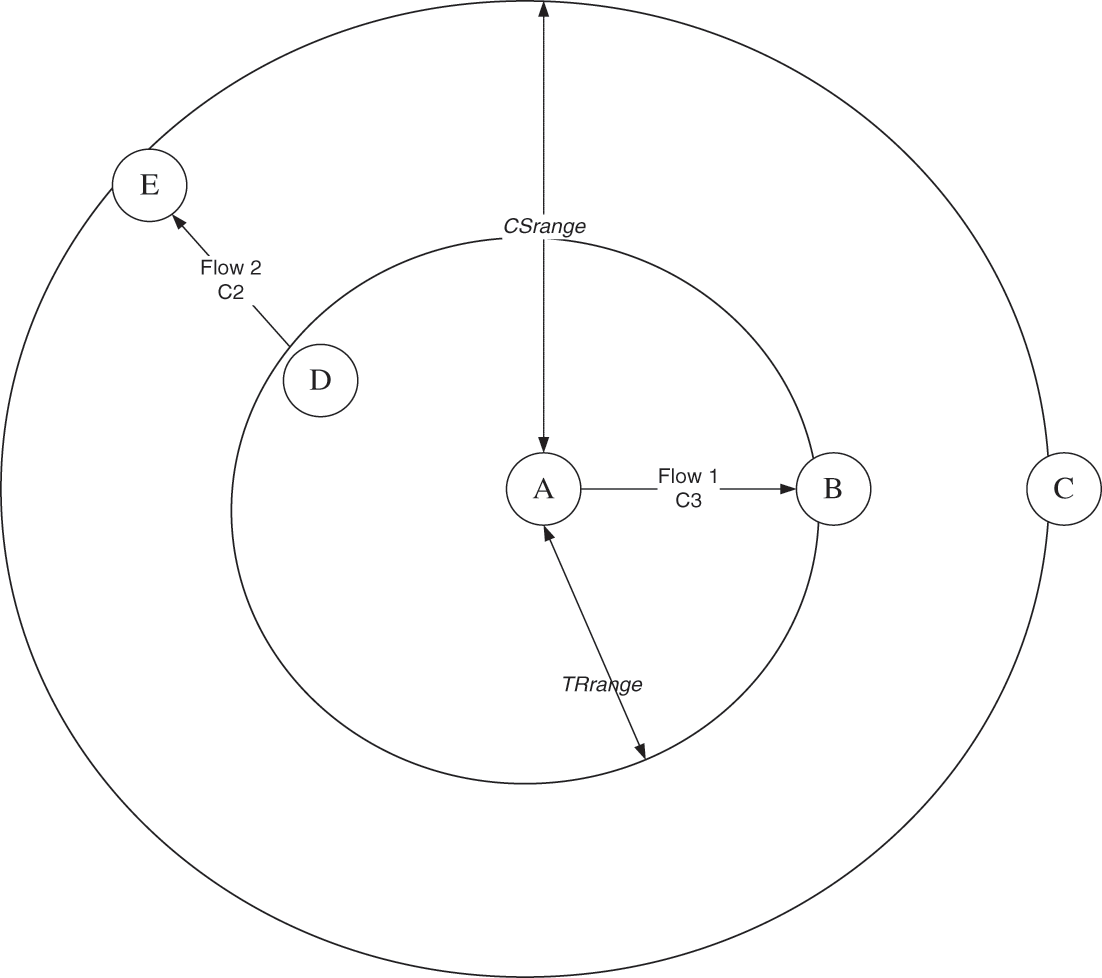
Figure 9: Throughput using the proposed algorithm
4.4 Evaluation of the Proposed Algorithm’s Performance
Table 2 shows the throughput values obtained by each flow during the simulation and the comparison results of the throughput of RCA with the proposed algorithm.
Fig. 10 shows the impact of interference on the topology by comparing the results of RCA with the proposed algorithm and shows the results of the evaluation performed by the proposed work, whereas f1 and f2 are used for flows. The proposed system has a higher average throughput than RCA. This is true for both coordinated and uncoordinated interference.

Figure 10: Evaluation results of our proposed strategy
The findings discussed above show how the technique improves evaluation performance and throughput. Channel allocation in the CR-dynamic WMN. The RCA method reduces the amount of coordinated and uncoordinated interference. Low CR-WMN throughput is caused by an increase in the chance of interference as the number of channels increases. As a result, using our proposed technique increases the throughput for both coordinated and uncoordinated interferences. A few further difficulties, such as free channels that are available for transmission but are not used, resulting in excessive energy consumption, must be addressed in future research. A method for exchanging trustworthy knowledge about routes between nodes is also required.
Because of its adaptability, the CR-WMN has stood out among numerous network topologies. It is made up of an ad-hoc network and a wireless LAN. There has been researched into existing channel allocation algorithms and principles. The usage of MRMC in CR-WMN can enhance network capacity; nevertheless, interference in the network increases owing to link meshing, which has a negative impact on network throughput. So, in this study, they proposed utilization of coordinated and non-coordinated interference for dynamic channel allocation in CR-WMN based on RCA using unsupervised learning. When the simulation results of RCA and our suggested algorithm are compared, it is found that our proposed approach outperforms RCA, and the simulation results reveal that throughput has improved by 34% on average for both coordinated and non-coordinated interference.
Acknowledgement: I extend my heartfelt gratitude to my supervisor, funding company, family, and friends for their invaluable support throughout this research.
Funding Statement: This work is funded by the National Natural Science Foundation of China (61971014), Zhang Jianbiao.
Author Contributions: The final manuscript was read and approved by all authors. The study design, literature search, reading, analyzing, and modeling were all done by KA and HI. The manuscript was written by KA and MY, and it was critically revised by ZJ, MDA and ISC. ZJ was also in charge of supervision.
Availability of Data and Materials: Data and materials are available upon request.
Conflicts of Interest: The authors declare that they have no conflicts of interest to report regarding the present study.
References
1. S. S. Bhojannawar and S. R. Mangalwede, “A review of joint channel assignment and routing protocols for wireless mesh networks,” in Proc. of the First Int. Conf. on Computational Intelligence and Informatics, Singapore, pp. 157–17, 2017. [Google Scholar]
2. A. Panigrahi, C. Rout, C. Badjena and H. Das, “Dynamic channel assignment strategies in multi radio wireless mesh network,” in Int. Conf. on Information Technology: (ICIT), Bhubaneswar, Odisha, India, pp. 27–32, 2018. [Google Scholar]
3. M. Pirmoradian, O. Adigun and C. Politis, “Entropy-based opportunistic spectrum access for cognitive radio networks,” Transactions on Emerging Telecommunications Technologies, vol. 28, no. 1, pp. e2886, 2017. [Google Scholar]
4. M. Almasri, A. Mansour, C. Moy, A. Assoum, C. Osswald et al., “Distributed algorithm under cooperative or competitive priority users in cognitive networks,” EURASIP Journal on Wireless Communications and Networking, vol. 2020, no. 1, pp. 1–31, 2020. [Google Scholar]
5. Y. Wang, F. Shang and J. Lei, “Reliability optimization for channel resource allocation in multi-hop wireless network: A multi-granularity deep reinforcement learning approach,” IEEE Internet Things Journal, vol. 22, no. 1, pp. 1–20, 2022. [Google Scholar]
6. A. Chineke and A. Patrick, “Improve dynamic spectrum allocation scheme in cognitive radio wireless mesh network using mixed integer non linear programming,” International Journal of Trend in Research and Development, vol. 5, no. 2, pp. 538–541, 2018. [Google Scholar]
7. S. Mansour and S. D. Meinrath, “2 Building community wireless networks: A how-to guide for the curious,” The Community Network Manual: How to Build the Internet Yourself, vol. 1, no. 1, pp. 43, 2018. [Google Scholar]
8. F. Hussain, W. Li, B. Noye, S. Sharieh and A. Ferworn, “Intelligent service mesh framework for API security and management,” in 2019 IEEE 10th Annual Information Technology, Electronics and Mobile Communication Conf. (IEMCON), Vancouver, Canada, pp. 0735–0742, 2019. [Google Scholar]
9. Q. Zheng, P. Zhao, Y. Li, H. Wang and Y. Yang, “Spectrum interference-based two-level data augmentation method in deep learning for automatic modulation classification,” Neural Computing and Applications, vol. 33, no. 13, pp. 7723–7745, 2021. [Google Scholar]
10. M. Rethfeldt, T. Brockmann, B. Beichler, C. Haubelt and D. Timmermann, “Adaptive multi-channel clustering in IEEE 802.11s wireless mesh networks,” Sensors, vol. 21, no. 21, pp. 7215, 2021. [Google Scholar] [PubMed]
11. D. V. Queiroz, R. D. Gomes, I. E. Fonseca, M. S. Alencar and C. Benavente-Peces, “Channel assignment in TSCH-based wireless sensor networks using fuzzy logic,” Journal of Ambient Intelligence and Humanized Computing, vol. 1, no. 1, pp. 1–20, 2021. [Google Scholar]
12. R. Kufakunesu, G. P. Hancke and A. M. Abu-Mahfouz, “A survey on adaptive data rate optimization in lorawan: Recent solutions and major challenges,” Sensors, vol. 20, no. 18, pp. 5044, 2020. [Google Scholar] [PubMed]
13. P. Karimi, “Algorithms and protocols for enhancement of spectrum utilization in future mobile networks,” Ph.D. Dissertations New Jersey, School of Graduate, New Brunswick, USA, 2019. [Google Scholar]
14. P. Amrutanshu, S. Bibhuprasad, S. S. Panigrahi and M. S. Khan, “Impact of optimized segment routing in software defined networks,” in New Advanced Society Artificial Intelligence and Industrial Internet of Things Paradigm. Willey, pp. 263–287, 2022. [Google Scholar]
15. Y. S. Nasir and D. Guo, “Multi-agent deep reinforcement learning for dynamic power allocation in wireless networks,” IEEE Journal on Selected Areas in Communications, vol. 37, no. 10, pp. 2239–2250, 2019. [Google Scholar]
16. F.A. Ghaleb, B.A.S. Al-Rimy, W. Boulila, F. Saeed, M. Kamat, F.Rohani et al., “Fairness-oriented semichaotic genetic algorithm-based channel assignment technique for node starvation problem in wireless mesh networks,” Intelligence and Neuroscience, vol. 2021, no. 1, pp. 1–19, 2021. [Google Scholar]
17. M. Islam, “Dynamic traffic engineering for high-throughput data delivery in wireless mesh networks,” Ph.D. dissertation, University of Dhaka, Bangladesh, 2018. [Google Scholar]
18. Y. Chai and X. J. Zeng, “The development of green wireless mesh network: A survey,” Journal of Smart Environments and Green Computing, vol. 1, no. 1, pp. 47–59, 2021. [Google Scholar]
19. Y. S. Song, S. K. Lee and K. W. Min, “A study on the performance of multi-channel communication protocol for intelligent connected autonomous driving system,” in Int. Conf. on Information and Communication Technology Convergence (ICTC), Jeju Island, Korea, pp. 863–865, 2021. [Google Scholar]
20. K. Arshid, I. Hussain, M. K. Bashir, S. Naseem, A. Ditta et al., “Primary user traffic pattern based opportunistic spectrum handoff in cognitive radio networks,” Applied Sciences, vol. 10, no. 5, pp. 1674–1693, 2020. [Google Scholar]
21. K. Arshid, Z. Jianbiao, I. Hussain, M. S. Pathan, M. Yaqub et al., “Energy efficiency in cognitive radio network using cooperative spectrum sensing based on hybrid spectrum handoff,” Egyptian Informatics Journal, vol. 23, no. 4, pp. 1–12, 2022. [Google Scholar]
22. S. Tschimben, “Anomaly detection in shared spectrum,” Ph.D. dissertation, University of Colorado at Boulder, USA, 2022. [Google Scholar]
23. T. Pan, Y. Nianbing, J. Chenhao, P. Jianwen, X. Liang et al., “Sailfish: Accelerating cloud-scale multi-tenant multi-service gateways with programmable switches,” in Proc. of the 2021 ACM SIGCOMM Conf.,New York, USA, pp. 194–206, 2021. [Google Scholar]
24. Y. Zou, J. Zhu, T. Wu, H. Guo and H. Wei, “Cooperative drone communications for space-air-ground integrated networks,” IEEE Network, vol. 35, no. 5, pp. 100–106, 2021. [Google Scholar]
25. V. Sujatha, C. S. Bindu, G. V. Kumar and P. D. K. Reddy, “An adaptive channel assignment strategy for multi-radio multi-channel wireless mesh networks with mobile nodes based on internet traffic,” in Proc. of the 2nd Int. Conf. on Computational and Bio Engineering, Tirupati, India, pp. 651–660, 2021. [Google Scholar]
26. K. M. Fouad, B. M. Hassan and O. M. Salim, “Hybrid sensor selection technique for lifetime extension of wireless sensor networks,” Computers, Materials & Continua, vol. 70, no. 3, pp. 4965–4985, 2022. [Google Scholar]
27. W. A. Khan, F. Ahmad, S. A. Alanazi, T. Hasan, S. Naseem et al., “Trust identification through cognitive correlates with emphasizing attention in cloud robotics,” Egyptian Informatics Journal, vol. 1, no. 1, pp. 1–16, 2022. [Google Scholar]
28. G. Mehmood, M. Z. Khan, M. Fayaz, M. Faisal, H. U. Rahman et al., “An energy-efficient mobile agent-based data aggregation scheme for wireless body area networks,” Computers, Materials & Continua, vol. 70, no. 3, pp. 5929–5948, 2022. [Google Scholar]
29. M. Mehmood, “Improved colorization and classification of intracranial tumor expanse in MRI images via hybrid scheme of Pix2Pix-cGANs and NASNet-large,” Journal of King Saud University—Computer and Information Sciences, vol. 1, no. 1, pp. 1–17, 2022. [Google Scholar]
30. K. Arshid, Z. Jianbiao, I. Hussain, G. G. Lema, M. Yaqub et al., “Support vector machine approach of malicious user identification in cognitive radio networks,” Wireless Networks, vol. 1, no. 4, pp. 1–12, 2022. [Google Scholar]
Cite This Article
 Copyright © 2023 The Author(s). Published by Tech Science Press.
Copyright © 2023 The Author(s). Published by Tech Science Press.This work is licensed under a Creative Commons Attribution 4.0 International License , which permits unrestricted use, distribution, and reproduction in any medium, provided the original work is properly cited.


 Submit a Paper
Submit a Paper Propose a Special lssue
Propose a Special lssue View Full Text
View Full Text Download PDF
Download PDF Downloads
Downloads
 Citation Tools
Citation Tools
